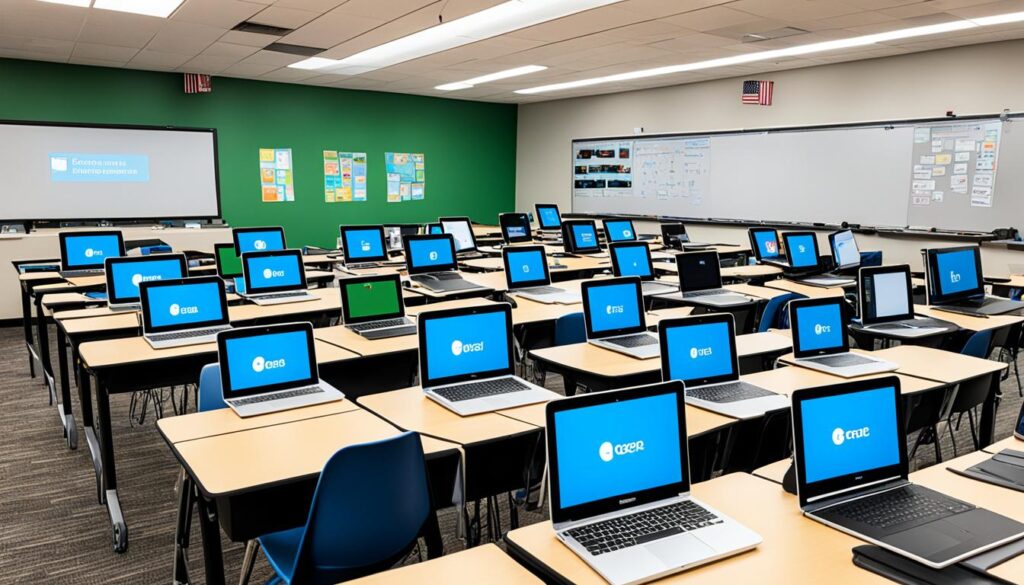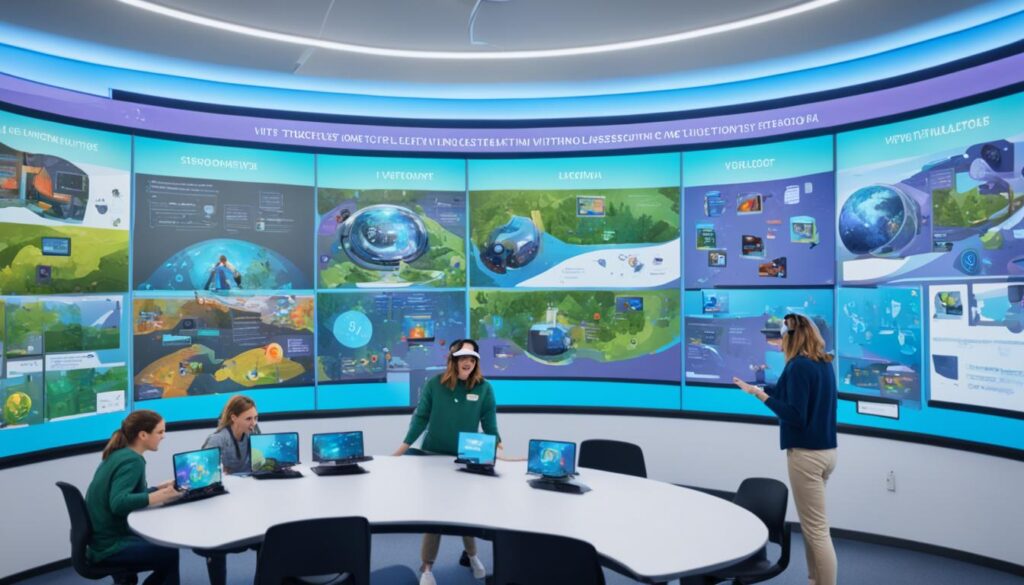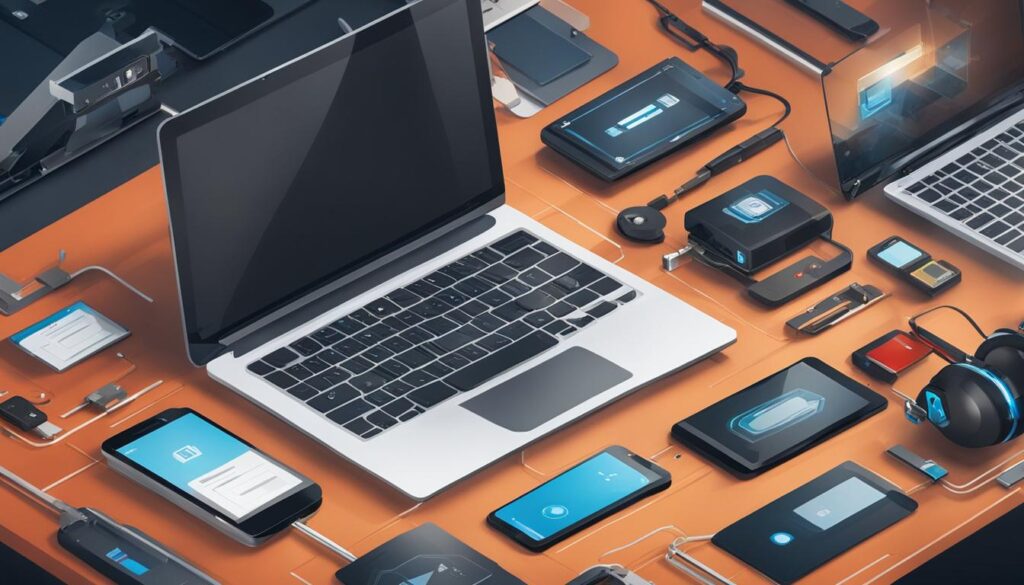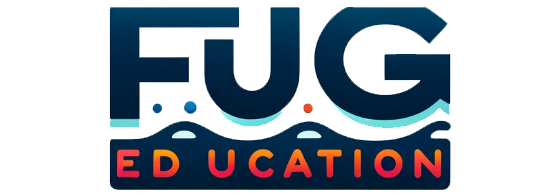Education technology is constantly evolving, bringing forth a wave of innovative solutions and advancements. From personalized learning experiences to cutting-edge tools and platforms, the field of education technology, or EdTech, is revolutionizing traditional classrooms and transforming the way we teach and learn. This article will delve into the latest innovations, emerging trends, and the impact of technology on educators and students.
Key Takeaways:
- Education technology is driving significant advancements in the classroom.
- Personalized learning experiences and innovative tools are becoming the norm.
- The field of EdTech is constantly evolving, with emerging trends shaping the future of education.
- Technology has a profound impact on both educators and students.
- Continuous updates and integration of new tools are essential in education technology.
Introduction: Navigating the Digital Transformation in Education
The digital transformation in education is an ongoing process that aims to integrate technology into every aspect of the learning experience. As technology continues to evolve, it has become increasingly important for educators to stay updated on the latest education technology trends and technological advancements in education.
Technology is reshaping classrooms and revolutionizing the way students learn. With the integration of education technology, teachers can enhance teaching methodologies and create more engaging and effective educational experiences for their students.
“The future of education lies in embracing innovation and leveraging the potential of technology to create more dynamic and effective learning environments.”
In this section, we will explore the current trends and advancements in education technology, providing you with valuable insights and knowledge to navigate the digital transformation in education.
The Rise of EdTech in Modern Classrooms
The rise of education technology (EdTech) has revolutionized modern classrooms, providing new opportunities for teaching and learning. As schools worldwide embrace digital transformation, EdTech adoption has become increasingly prevalent to enhance student engagement, improve educational outcomes, and create a more personalized learning experience.
One of the key benefits of EdTech is the emergence of blended learning environments. Blended learning combines online and in-person instruction, allowing for a flexible and tailored approach to education. Through a combination of digital resources, virtual classrooms, and face-to-face interaction, students can access content at their own pace, receive immediate feedback, and engage in collaborative activities.
Furthermore, gamification has gained prominence in EdTech adoption. By incorporating game elements into educational experiences, such as leaderboards, badges, and rewards, gamification promotes active participation and motivates students to reach their learning goals. It creates an immersive and interactive environment that fosters engagement, problem-solving skills, and critical thinking.
In addition to blended learning and gamification, community platforms play a crucial role in modern classrooms. These platforms enable students and teachers to connect, collaborate, and share resources beyond the physical classroom. By facilitating communication and collaboration, community platforms encourage active participation, peer learning, and the exchange of ideas.
Data-driven personalization is another significant aspect of EdTech in modern classrooms. By leveraging student data, such as performance, preferences, and learning styles, educators can tailor instruction to meet individual needs. Personalized learning paths ensure that students receive targeted support and materials, enabling them to achieve their full potential.

Innovations in Education Technology
Education technology is constantly evolving, offering innovative solutions that are transforming the educational landscape. From interactive whiteboards to virtual reality, cutting-edge educational technology is revolutionizing teaching and learning experiences. By staying up-to-date with the latest trends and leveraging these innovative ed tech solutions, educators can create more dynamic and effective classrooms.
“The future of education lies in embracing innovation and leveraging the potential of technology to create more dynamic and effective learning environments.”
One of the key innovations in education technology is the use of interactive whiteboards. These advanced tools allow teachers to create engaging and interactive lessons that cater to different learning styles. By incorporating multimedia elements and interactive activities, educators can capture students’ attention and enhance their understanding of complex concepts.
Another groundbreaking innovation is virtual reality (VR) technology, which provides immersive learning experiences beyond the confines of the classroom. With VR, students can explore historical landmarks, dive into realistic simulations, and actively participate in virtual experiments, fostering deeper engagement and experiential learning.
Adaptive learning platforms are also revolutionizing education by personalizing the learning experience for each student. These platforms leverage artificial intelligence and machine learning algorithms to adapt content and learning activities based on the individual needs and progress of each learner. This tailored approach promotes self-paced learning and ensures that students receive the support and resources they need to succeed.
Educational apps are another area of innovation in education technology. These mobile applications provide access to educational resources and interactive content anytime, anywhere. From language learning apps to math games, these apps make learning more accessible and engaging for students.
| Key Innovations in Education Technology | Benefits |
|---|---|
| Interactive Whiteboards | Enhanced engagement and understanding through interactive lessons |
| Virtual Reality | Immersive learning experiences beyond the classroom |
| Adaptive Learning Platforms | Personalized learning experiences tailored to individual students |
| Educational Apps | Access to educational resources anytime, anywhere |
These innovations in education technology are shaping the future of education, providing educators with powerful tools to enhance teaching and learning outcomes. By embracing these cutting-edge technologies, educators can create more engaging, personalized, and effective learning environments that prepare students for success in an increasingly digital world.
Emerging Technologies and Their Potential in Education
Emerging technologies have the potential to revolutionize education and provide new opportunities for teaching and learning. In this section, we will explore three key emerging technologies: virtual reality, artificial intelligence, and learning analytics and big data. These technologies offer exciting possibilities for enhancing the educational experience and improving student outcomes.
1. Virtual Reality in Education
Virtual reality (VR) technology creates immersive learning experiences that go beyond the traditional classroom setting. By using VR headsets and interactive simulations, students can explore virtual worlds and engage in hands-on activities. VR can transport students to historical events, distant landscapes, or even microscopic environments, enabling them to visualize and experience complex concepts like never before. This technology enhances student engagement, fosters critical thinking skills, and promotes deeper understanding.

2. Artificial Intelligence in Education
Artificial intelligence (AI) has the power to transform the learning experience by tailoring it to individual students’ needs. AI algorithms can analyze vast amounts of data to identify students’ strengths, weaknesses, and learning styles. With this knowledge, AI-enabled adaptive learning platforms can deliver personalized content, providing students with targeted support and challenges. AI can also automate administrative tasks, freeing up teachers’ time for personalized instruction and mentorship. The integration of AI in education enhances student engagement, promotes self-directed learning, and enables more efficient and effective teaching practices.
3. Learning Analytics and Big Data
Learning analytics and big data offer valuable insights into student performance, engagement, and learning patterns. By gathering and analyzing data from various sources such as online platforms, learning management systems, and assessment tools, educators can make data-driven decisions to improve instructional strategies. Learning analytics enable educators to identify at-risk students, provide timely interventions, and personalize learning experiences. Big data analysis can also inform curriculum design, identify trends, and improve educational policies. Harnessing the power of learning analytics and big data leads to more effective teaching practices, enhanced student success, and informed decision-making.
Latest Trends in Education: Table
| Technology | Potential Benefits |
|---|---|
| Virtual Reality | Immersive learning experiences, enhanced engagement, deeper understanding |
| Artificial Intelligence | Personalized learning, adaptive content, efficient administrative tasks |
| Learning Analytics and Big Data | Insights for data-driven decisions, personalized support, improved student outcomes |
The Evolving Role of Educators in Tech-Enhanced Learning
Technology has revolutionized the role of educators in the modern classroom. With the integration of education technology, educators have transformed into facilitators in a technological era, guiding students through engaging and interactive learning experiences. This section will delve into the evolving role of educators in tech-enhanced learning, highlighting the importance of real-time data and personalized feedback in empowering educators to deliver tailored support and modify instructional methods for each student.
“Education is no longer about teaching facts and figures; it’s about equipping students with the necessary skills to thrive in a rapidly changing world,” says Sarah Johnson, an educational technology specialist.
Traditionally, educators were focused on delivering content and assessments in a one-size-fits-all manner. However, technology has provided the tools and resources for educators to personalize their approach and cater to the individual needs of each student. Real-time data allows educators to gather insights into students’ progress and areas of improvement. By analyzing this data, educators can identify gaps in knowledge, customize content delivery, and provide targeted interventions to support student learning.
Furthermore, personalized feedback plays a crucial role in enhancing the learning experience. With technology, educators can provide timely and specific feedback to students, enabling them to understand their strengths and weaknesses while guiding them towards improvement. Whether through comments on online assignments or interactive quizzes that provide instant feedback, personalized feedback fosters a growth mindset, motivates students, and encourages continuous learning.
The evolving role of educators in tech-enhanced learning goes beyond content delivery. Educators now have the opportunity to foster critical thinking, collaboration, and problem-solving skills through technology-enabled projects and activities. They facilitate discussions, encourage creativity, and guide students in utilizing digital tools for research, analysis, and presentation of information.
The inclusion of technology in education also promotes active engagement and student-centered learning. Technology offers interactive simulations, virtual field trips, and immersive experiences that bring abstract concepts to life. By incorporating these tools, educators can create dynamic, multisensory learning environments where students are active participants in their own education.
In conclusion, the role of educators in the digital era is one of facilitators, guiding students through technology-enabled learning experiences. The integration of real-time data and personalized feedback empowers educators to provide tailored support and modify instructional methods to meet the individual needs of each student. By embracing technology and leveraging its potential, educators can create engaging and effective learning environments that prepare students for success in the 21st-century workforce.
Empowering Students for the Future
Education technology plays a crucial role in empowering students to develop the skills they need to thrive in the future. In an ever-changing world, it is vital for students to acquire a set of competencies that can prepare them for the challenges ahead. This section will focus on three key aspects of skills development for tomorrow’s challenges, including:
- Critical Thinking: Education technology encourages students to think critically and analyze information to make informed decisions. Through interactive digital platforms and resources, students can develop their analytical and evaluative skills, enabling them to solve complex problems effectively.
- Problem-Solving: The integration of technology in education nurtures problem-solving abilities in students. By engaging with interactive simulations and virtual environments, students can explore real-world scenarios and apply their knowledge to find innovative solutions.
- Digital Literacy: Responsible digital citizenship is a fundamental aspect of skills development in today’s digital era. Education technology provides opportunities for students to learn about online safety, digital ethics, and responsible use of technology. By developing digital literacy skills, students can navigate the digital landscape confidently and responsibly.
Furthermore, education technology also promotes self-directed learning. With access to online resources and interactive platforms, students can take ownership of their learning journey. They can explore their interests, pursue personalized learning paths, and engage in collaborative activities beyond the traditional classroom setting. Self-directed learning empowers students to take control of their education and develop valuable skills such as time management, initiative, and resourcefulness.
In conclusion, education technology plays a vital role in empowering students for the future. By fostering critical thinking, problem-solving, digital literacy, and self-directed learning, students can acquire the necessary skills to thrive in an increasingly digital world. It is essential for educators to embrace education technology as a catalyst for skills development and prepare students for the challenges and opportunities that lie ahead.
Addressing the Challenges in EdTech Implementation
Implementing education technology comes with its challenges. Successful EdTech implementation requires careful consideration of several key factors, including financial investment, training, privacy and security, and ethical use of student data.
Financial Investment
Integrating technology into the classroom requires a significant financial investment. Schools and educational institutions must allocate funds to purchase the necessary hardware, software, and online platforms. Additionally, ongoing maintenance and updates are essential to ensure the smooth functioning of these technological resources.
Training in Technology
One of the major challenges in EdTech implementation is providing adequate training to educators. It is crucial to equip teachers with the necessary skills and knowledge to effectively integrate technology into their teaching practices. Professional development programs, workshops, and ongoing support are essential to enable teachers to navigate the digital landscape and leverage technology to enhance student learning outcomes.
Privacy and Security
In an age of increasing digital connectivity, privacy and security are significant concerns in EdTech implementation. Schools must implement robust data protection measures to safeguard student information. This includes ensuring compliance with relevant privacy laws and regulations, implementing secure user authentication systems, and fostering a culture of responsible data handling among educators and administrators.
Ethical Use of Student Data
The ethical use of student data is crucial in EdTech implementation. Educational institutions need to establish clear policies and frameworks for collecting, storing, and using student data. Schools must prioritize the privacy and consent of students and their families, ensuring that data is used responsibly and solely for educational purposes. Transparency and open communication are vital to maintain trust and confidence in the ethical handling of student data.

Addressing these challenges requires a collaborative effort between educators, administrators, and technology providers. By prioritizing financial investment, comprehensive training programs, robust privacy and security protocols, and ethical use of student data, educational institutions can navigate the complexities of EdTech implementation and harness its full potential to enhance teaching and learning experiences.
Case Studies: Success Stories of Technology in Classrooms
Real-world examples of successful technology implementation in classrooms can provide valuable insights into the benefits of educational software solutions, online learning platforms, and mobile learning apps. These case studies highlight the transformative impact of these tools in enhancing teaching and learning outcomes.
“Integrating an online learning platform allowed City Elementary School to create a more interactive and personalized learning experience for their students. The platform provided a wide range of educational resources, including interactive lessons, multimedia content, and collaborative tools. As a result, student engagement and motivation significantly increased, leading to improved academic performance.”
Another case study focused on the implementation of mobile learning apps in a high school setting. By leveraging mobile apps like Math Master and Language Lab, the school witnessed a notable improvement in student performance and participation. These apps provided interactive exercises, quizzes, and real-time feedback, enabling students to practice and reinforce their skills anytime, anywhere.
Furthermore, educational software solutions have revolutionized the classroom experience at Sunshine Academy. The integration of adaptive learning software tailored to each student’s needs allowed for personalized instruction and continuous progress monitoring. This approach led to better learning outcomes, as students received targeted support based on their individual strengths and areas for improvement.
These case studies exemplify the transformative power of educational technology. By leveraging educational software solutions, online learning platforms, and mobile learning apps, schools and institutions are revolutionizing the learning experience, fostering student engagement, and improving academic outcomes.
| Case Study | Technology Implemented | Impact |
|---|---|---|
| City Elementary School | Online learning platform | Increased student engagement and improved academic performance |
| High School X | Mobile learning apps (Math Master, Language Lab) | Improved student performance and participation |
| Sunshine Academy | Adaptive learning software | Personalized instruction and improved learning outcomes |
Preparing for a World of Ongoing EdTech Advancements
Education technology is constantly evolving, and educators must be prepared to adapt to ongoing advancements. It is crucial to prioritize continuous updates in educational software and platforms to ensure the use of the latest tools and technologies. By staying up-to-date, educators can provide students with a modern and engaging learning experience.
Integrating new tools is also essential in embracing the potential of education technology. By introducing innovative solutions, such as interactive learning apps or virtual reality experiences, educators can enhance student engagement and promote active participation in the learning process. However, it is crucial to preserve core teaching values while integrating these new tools.
Preserving core teaching values ensures that technology remains a tool rather than a distraction. It allows educators to maintain a balance between technology and traditional teaching methods, creating a learning environment where students can develop critical thinking, problem-solving, and communication skills. By combining the best of both worlds, educators can create a balanced and effective learning environment that prepares students for the challenges of the future.
Conclusion: Embracing the Future of Education Through Innovation
In conclusion, the future of education lies in embracing innovation and harnessing the transformative power of education technology. The rapid advancements in technology have revolutionized teaching and learning experiences, paving the way for a more dynamic and effective educational environment. By staying updated on the latest innovations and emerging trends, educators can create engaging and personalized learning experiences that prepare students for the challenges of the future.
Education technology has the potential to revolutionize the traditional classroom setting by offering new tools and solutions to enhance teaching and learning outcomes. By leveraging the latest innovations, educators can create interactive and immersive learning experiences that cater to the individual needs of students. From interactive whiteboards and virtual reality to adaptive learning platforms and educational apps, the possibilities are endless.
As we move into the future, it is important for educators to continuously update their educational software and platforms to integrate new tools and technologies. By doing so, they can ensure that they are providing the best possible learning experiences for their students while preserving core teaching values. Embracing innovation in education technology is not just a trend but a necessity in preparing students for the challenges they will face in the future.
Through education innovation, we can transform the way we teach and learn, creating a more dynamic, engaging, and effective educational environment. By embracing the future of education through innovation, we can revolutionize the way we prepare students for the challenges of the future and empower them to thrive in a rapidly changing world.
FAQ
What are some of the latest innovations in education technology?
Some of the latest innovations in education technology include interactive whiteboards, virtual reality tools, adaptive learning platforms, and educational apps. These technologies are transforming the way students learn and engage with educational content.
How is technology revolutionizing the traditional classroom setting?
Technology is revolutionizing the traditional classroom setting by providing personalized learning experiences, integrating advanced tools and platforms, and creating more dynamic and effective learning environments.
What are the emerging technologies that have the potential to revolutionize education?
Virtual reality, artificial intelligence, and learning analytics with big data are the emerging technologies that have the potential to revolutionize education. These technologies can create immersive learning experiences, tailor the learning process to individual students, and inform instructional strategies.
How are educators adapting to the role of technology facilitators?
Educators are adapting to the role of technology facilitators by guiding students through technology-enabled learning experiences, using real-time data to modify instructional methods, and providing personalized feedback and support to each student.
What skills do students need to develop for the future?
Students need to develop skills such as critical thinking, problem-solving, and digital literacy to thrive in the future. They must also understand responsible digital citizenship and be able to engage in self-directed learning.
What are the challenges in implementing education technology?
Implementing education technology can be challenging due to the financial investment and training required for successful implementation. Privacy, security, and ethical use of student data are also important considerations in an interconnected digital environment.
Can you provide some successful case studies of technology implementation in classrooms?
There are numerous successful case studies of technology implementation in classrooms. For example, schools and institutions have leveraged educational software solutions, online learning platforms, and mobile learning apps to enhance teaching and learning outcomes.
Why is continuous updating of educational software and platforms important?
Continuous updating of educational software and platforms is important to ensure the use of the latest tools and technologies. By staying up-to-date, educators can create more effective learning environments for their students.
How can educators integrate new technology while preserving core teaching values?
Educators can integrate new technology while preserving core teaching values by carefully selecting tools and platforms that align with their educational goals. It’s important to strike a balance between innovation and maintaining the core principles of effective teaching.
Source Links
- https://technologyforlearners.com/revolutionizing-the-classroom-a-look-at-emerging-educational-technologies/
- https://englishpluspodcast.com/revolutionizing-education-how-technology-is-transforming-modern-classrooms/
- https://www.linkedin.com/pulse/revolutionizing-education-unleashing-power-ed-tech-smart

